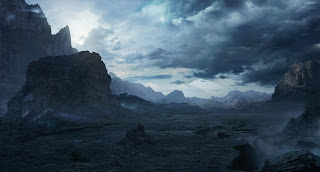Matte painting are very useful in the media industry especially film makers. Matte painting are a representation of landscape created by the film maker. This is done to create the illusion of an environment, that either doesn't exist or expensive to use, and impossible to visit or build.

Matte paintings go all the way back to 1905. A man called Norman Dawn developed a technique, that uses both photography and paintings to enhance the location being shot by camera. A photographer himself, he took his own photos and paintings and placed them on a large glass sheet. After positioning the camera in the right position the live footage would take place. This resulted a combination between a simple painting and and actual live scenery.
Back in the day when matte paintings first came out, they were either created by hand or mixed with photos. Roughly around 80 years after Dawn's creation, they started using computer and programmes came with its own digital paintings. This enhance to realism of the environment. In 1985, painter Chris Evans was the first to create a digital matte painting used in the film 'Young Sherlock Holmes'. Which leads to matte paintings we see today in films.
This clip shows the original background was and what it changed to in the filming, to show it fits in the rest of the film.





















































